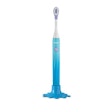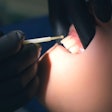Surgeons at Johns Hopkins Hospital in Baltimore have removed a rare brain tumor containing several teeth from a 4-month-old baby boy.
The tumor was an adamantinomatous craniopharyngioma, a slow-growing mass that can press up against the pituitary gland and optic nerve and cause pressure in the brain. It is mostly found in young children.
Only five other cases in medical literature found teeth in these types of tumors, Edward Ahn, MD, a pediatric neurosurgeon at Johns Hopkins who was the lead surgeon in the case, told the Baltimore Sun. The surgeons wrote about the unusual case in the latest issue of the New England Journal of Medicine (February 27, 2014, Vol. 370:9, p. 860; images can be seen here).
The tumor was found in 2012 after a pediatrician noticed that the baby's head was unusually large for his age. The baby was initially seen by the pediatrician for nasal congestion, but doctors discovered that the boy's head had grown significantly since a routine visit two weeks prior.
Contrast-enhanced MRI revealed a heterogeneous, enhancing suprasellar mass (4.1 cm x 4.0 cm x 3.5 cm). During tumor resection, the patient was discovered to have a solid tumor with white pieces, which were found to be multiple fully formed teeth. At first, Dr. Ahn thought these pieces were calcium, which is not unusual in these tumors, as craniopharyngioma tumors are formed from the lining of the brain or back of the mouth and often have calcium inside.
Adamantinomatous craniopharyngiomas arise from the Rathke's pouch, an embryonic precursor to the anterior pituitary. "Such tumors consist of organized stratified squamous epithelium and wet keratin (keratin nodules) and may be cystic; the cysts are filled with viscous, yellow fluid containing cholesterol crystals," the case report authors wrote. "Histologically, adamantinomatous craniopharyngiomas closely resemble some odontogenic tumors and cysts."
The boy, now 2 years old, is making good developmental progress, but continues to have some vision problems and is on thyroid and adrenal hormone-replacement therapy. The surgeons could not remove all the tumor because it was located close to major blood vessels, so the boy also undergoes routine MR imaging.
The discovery gives researchers more insight into the origins of the tumor, Dr. Ahn said.



















